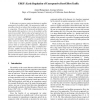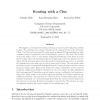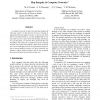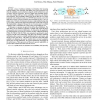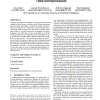ICC
2007
IEEE
14 years 3 months ago
2007
IEEE
Router-level maps of the Internet implicate a large body of research on network management, overlay networks, performance evaluation, and security. The inaccuracies in these maps r...
INFOCOM
1998
IEEE
14 years 3 months ago
1998
IEEE
Abstract--This paper presents a novel loss recovery scheme, Active Reliable Multicast (ARM), for large-scale reliable multicast. ARM is "active" in that routers in the mu...
ICNP
1999
IEEE
14 years 3 months ago
1999
IEEE
In this paper, we propose router mechanisms to regulate unresponsive best-effort traffic. By unresponsive traffic we mean flows that do not reduce their sending rate in response t...
SIGCOMM
1999
ACM
14 years 3 months ago
1999
ACM
We suggest a new simple forwarding technique to speed-up IP destination address lookup. The technique is a natural extension of IP, requires 5 bits in the IP header (IPv4, 7 in IP...
ICNP
2000
IEEE
14 years 3 months ago
2000
IEEE
A computer network is said to provide hop integrity iff when any router p in the network receives a message m supposedly from an adjacent router q, then p can check that m was ind...
DAC
2009
ACM
14 years 4 months ago
2009
ACM
Process scaling has given designers billions of transistors to work with. As feature sizes near the atomic scale, extensive variation and wearout inevitably make margining unecono...
INFOCOM
2002
IEEE
14 years 4 months ago
2002
IEEE
— Recently, a class of solutions including Core-Stateless Fair Queueing (CSFQ), Rainbow Fair Queueing, and Diffserv have been proposed to address the scalability concerns that ha...
INFOCOM
2002
IEEE
14 years 4 months ago
2002
IEEE
Abstract—Many recent router architectures decouple the routing engine from the forwarding engine, so that packet forwarding can continue even when the routing process is not acti...
SIGCOMM
2004
ACM
14 years 4 months ago
2004
ACM
All Internet routers contain buffers to hold packets during times of congestion. Today, the size of the buffers is determined by the dynamics of TCP’s congestion control algor...
ANCS
2005
ACM
14 years 5 months ago
2005
ACM
This paper investigates the suitability of emerging tiled-architectures, equipped with low-latency on-chip networks, for high-performance network routing. In this paper, we presen...

